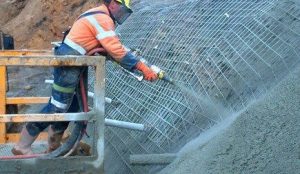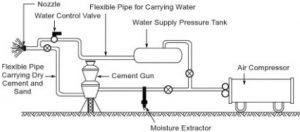What is Guniting? its 5 Uses, Procedure, and Advantages
Guniting
Guniting is a procedure in which repairing concrete work can be done that has been harmed due to inferior work or other reasons and providing an impervious layer is also used.
For the application of slope stabilization and certain rehabilitation purposes, the guniting process is used in construction such as in the construction of retaining walls, swimming pool construction, tunnel construction, concrete repair works, and in fluid tank construction.

The gunite is a mixture of cement and sand and 1:3 is the usual proportion under a pressure of about 20 to 30 N/cm2, a cement gun is used to deposit this mixture on the concrete surface.
The guniting can be used on vertical and overhead and as well as on the horizontal surface and for restoring surfaces spalled due to corrosion of reinforcement this process is particularly useful.
The Procedure of Guniting:
The guniting is also known as the dry-mix shotcrete process which carries dry material from a machine to the surface of application through a nozzle by means of high velocity and compressed pressure.
By the addition of water at the nozzle area, the application is facilitated and the mix that finally comes out is a combination of water and dry material. On the addition of water and the combination water content, the operator has control over it.
The mix used is cement mortar mix and there may be variations based on the application and requirements of the area as shown in fig below;

The dry ingredients are mixed in a bin and stored in a cement gun as shown in the figure above the dry mix is injected and the water is introduced at the nozzle just before the mix blast off during the time of application under the action of pressure and high velocity.
As shown in the fig above there is a water supply pressure tank that will supply water with adequate pressure to the nozzle.
Requirements for Good Quality Guniting:
There are the following requirements as given below;
- By having a careful and skilful operation and control of the nozzle a high-quality finished work through guniting is obtained.
- By high-pressure water jet or by air blast, the surface of the application must be free from dirt, grease, or any other defective materials and must be cleaned.
- Before undergoing guniting, sand-blasting can be carried out on the surface of the application which helps in removing rust on the reinforcement, and 10mm is the size of fine aggregate used in the mix.
- 1:3 and 1:4:5 is the mix proportion used for guniting and on the 7th day after application, a 1:3 mix will attain the strength of 70MPa.
- It is necessary to have a high-quality mortar and increase the resistance to weather and chemical attack in order to reduce permeability.
Uses of Guniting:
There are the following uses of guniting as listed below;
- In different construction such as thin overhead vertical or horizontal surfaces, curved or folded sections, canals, reservoirs, and tunnel lining it is widely used.
- In swimming pools, water retaining structures, and prestressed tanks it is also used.
- In the stabilization of rock slopes and temporary protection of freshly excavated rock surfaces, it has been successfully used.
- For protection against long-term corrosion of pilling, coal bunkers, oil tanks, steel building frames, and other structures are also used.
- For high-temperature applications, such as the refractory lining of kilns, chimneys, furnaces, etc these are developed.
Advantages of Guniting:
There are the following advantages of this as given below;
- For structures to occupy any shape such as undulating, spherical, or curves this method can be applied and in nature, this process is highly versatile.
- It is used in swimming pools, artificial caves, waterfalls, etc because of its versatility and it provides special shapes and features.
- The control of water is possible because the water added to the mix is carried out at the nozzle and while carrying out the spraying procedure this adjustment can be controlled instantly by the crew.
- The guniting mix can be prepared quickly as compared with the wet shotcrete process and this is more useful in overhead application.
- It is easy to operate and control and all the mechanism used in this process is too handy use.
- The results of this method will be more accurate because the operator can easily adjust all things very quickly at the time of application of this method.
- Segregation or sagging or sticking will be troubled due to its height of applications if it is the damp mix.
- The method is adaptable in very nominal works like filling their lock cracks, for small repair works of coating of the surface, etc.
Disadvantages of Guniting:
There are also some disadvantages such as;
- This process will require highly skilled and experienced labour.
- The majority of quality is concerned with the operator who performs this process.
- The issue of rebound of the mix occurs in this process.
- It may require cleanup and is a bit messy.

